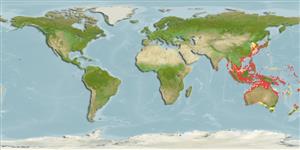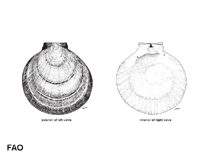Amusium japonicum (Gmelin, 1791)
Saucer scallop| Native range | All suitable habitat | Point map | Year 2050 |

|
| This map was computer-generated and has not yet been reviewed. |
| Amusium japonicum AquaMaps Data sources: GBIF OBIS |
Classification / Names Common names | Synonyms | CoL | ITIS | WoRMS
Bivalvia | Pectinida | Pectinidae
Environment: milieu / climate zone / depth range / distribution range Ecology
Benthic; depth range 0 - 80 m (Ref. 348), usually 0 - 30 m (Ref. 348). Tropical
Distribution Countries | FAO areas | Ecosystems | Occurrences | Introductions
Indo-West Pacific.
Length at first maturity / Size / Weight / Age
Maturity: Lm ? range ? - ? cm Max length : 14.0 cm ShL male/unsexed; (Ref. 348); common length : 11.0 cm SL male/unsexed; (Ref. 348)
Short description Morphology
Shell thin, medium to large sized (commonly exceeding to 10 cm in length), laterally compressed, almost circular in outline, gaping anteriorly and posteriorly. Both valves somewhat convex, the right (lower) valve only a little more inflated and larger than the left (upper) valve. Ears small, subequal in size and shape, with the right anterior ear faintly sinuated at anteroventral margin and devoid of ctenolium. Surface of left valve with 2 broad and very shallow depressed areas radiating from the umbo to anteroventral and radial lines. Interior of both valves with distinct radial ribs, usually in pairs, much narrower than the flat interspaces and becoming obsolete on umbonal area. Right valve with 42 to 54 internal radial ribs (46 to 54 in the typical subspecies A. japonicum, and 42 to 48 in the southern A. japonicum balloti). Colour: outside of left valve reddish brown, with variable shades along the concentric growth marks; outer colour pattern of subspecies balloti also with small, yellowish and dark brown spots along radial lines on umbonal area and often with a few irregular, larger dark spots towards periphery. Interior of left valve glossy to pale yellow externally and internally; subspecies balloti with an additional external brown scattering along some concentric growth marks.
On sandy to muddy bottoms of lagoons, often associated with brown seaweeds. Sublittoral mainly from shallow waters to about 30 m, but also deeper to more than 80 m. Can actively swim by clapping the valves when disturbed, with a speed of about 2 knots and for a distance of some 10 m (Ref. 348).
Life cycle and mating behavior Maturity | Reproduction | Spawning | Eggs | Fecundity | Larvae
Sexes separate. Spawning occurs in the cool season, from June to November. Growth is relatively rapid (about 7 to 8 cm in the first year), but the number of individuals reaching a 3 or 4 years age is small, because of a high rate of natural mortality.
Main reference
References | Coordinator | Collaborators
Poutiers, J.M. 1998. (Ref. 348)
IUCN Red List Status
(Ref. 130435: Version 2024-2)
CITES status (Ref. 108899)
Not Evaluated
CMS (Ref. 116361)
Not Evaluated
Threat to humans
Harmless
Human uses
Fisheries: commercial
| FishSource |
Tools
More information
Trophic Ecology
Food items
Diet composition
Food consumption
Food rations
Predators
Diet composition
Food consumption
Food rations
Predators
Ecology
Population dynamics
Growth
Max. ages / sizes
Length-weight rel.
Length-length rel.
Length-frequencies
Mass conversion
Recruitment
Abundance
Max. ages / sizes
Length-weight rel.
Length-length rel.
Length-frequencies
Mass conversion
Recruitment
Abundance
Life cycle
Distribution
Human Related
Aquaculture profiles
Stamps, coins, misc.
Stamps, coins, misc.
Outreach
References
Internet sources
BHL | BOLD Systems | CISTI | DiscoverLife | FAO(Publication : search) | Fishipedia | GenBank (genome, nucleotide) | GloBI | Gomexsi | Google Books | Google Scholar | Google | PubMed | Tree of Life | Wikipedia (Go, Search) | Zoological Record
Estimates based on models
Preferred temperature
(Ref. 115969): 18.7 - 29, mean 27.6 (based on 1304 cells).



